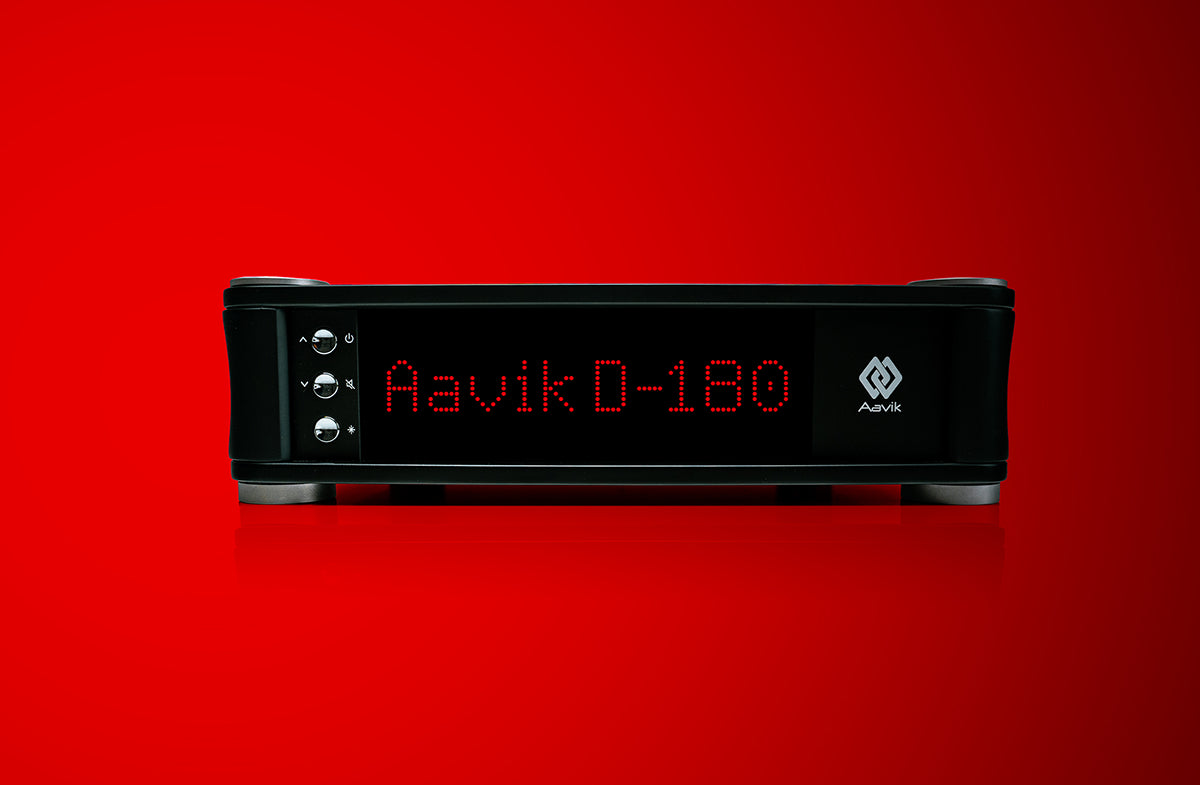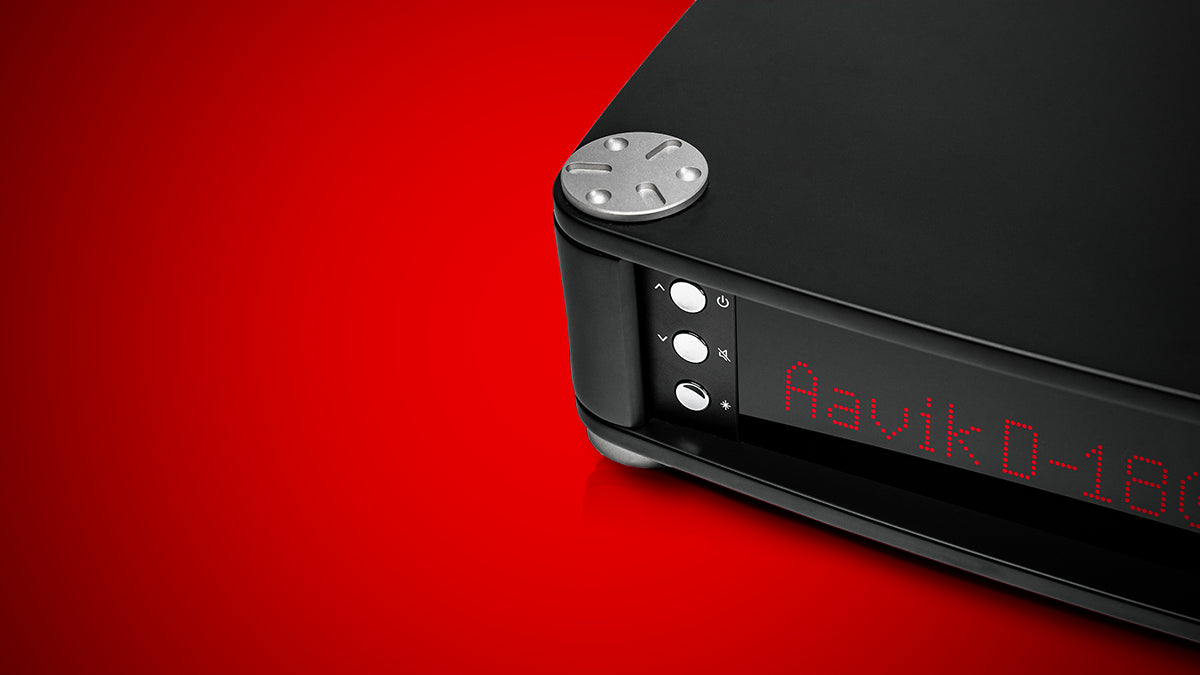Aavik
Aavik D-180 Digital/Analog Converter
Call for details: 904-642-6677
Estimated arrival date:

Aavik D-180
Digital/Analog Converter

Analog, warm and detailed
The D-180 DAC is handling the enormous amount of information contained in the digital source to a natural, warm yet detailed soundstage.

Technologies and Components
Analog signature.
Our ultimate goal in developing the Aavik DACs has been to transfer the digital signals into a natural, harmonious, yet, dynamic music experience without losing any of the enormous amount of information contained in the digital source. Our engineers have been extremely fastidious in selecting the electronic components and have spared no effort to exploit any opportunity for acoustic improvement.




13 Voltage regulatorsPer DAC circuit |
36 PCSActive Tesla Coil |
4Individual settings |

Scandinavian design with an international twist
The Aavik design is Scandinavian understatement and expresses simplicity and minimalism featuring only a few buttons for logical operation. The multifunctional main knob allows to navigate and control the various functions. We have boosted the self-confidence with a huge red display, which makes it easy to read all details of the selected operational settings.

A cabinet with excellent sonic qualities
The cabinet design represents a Aavik characteristic. The testing of new circuits and electronic components is often done without the enclosing cabinet. The disturbing sonic influence, which emanates from the material the cabinet is made of – mostly aluminium – results from its mechanical resonance. To eliminate this sonic distortion, the challenge was to minimize the use of aluminium in the cabinet to the absolute minimum that is unavoidable to ensure sufficient cooling. We began testing various materials and designed an innovative natural-based composite material, which reduces the mechanical influence, particularly the hysteresis. The sonic result is distinctly audible and reflects a further prominent cornerstone in Aavik’s quest for the ultimate music experience.

Shaping
Built like an instrument.
Our untiring endeavour to unlock further untapped sonic potentials to advance the quality of the listener’s musical experience, prompted us to look into the design and construction of musical instruments – both in terms of shape, as well as choice of material. A combination of the natural-based composite material, the contours and the ratio of the sizes can impact and define the tone. Too much damping kills the dynamics, whereas metallic resonances generate a bright and peaky sound – Aavik’s engineered enclosure offers the best of both worlds: an authentic sound that is warm, harmonious, and powerful, yet, at the same time, so crisp and refined that it highlights every single detail in the music.
Separates
No compromise.
The decision to build separate units reflects Aavik’s intent of space management without any sonic compromise. Allowing sufficient space for each segment, has also influenced the integration of a high-grade power supply with a huge capacity and paved the way for an effective cooling design.
By separating the individual units and redesigning them in a totally isolated fashion, the Aavik series has gained in dynamic momentum and a more expansive sound.

The DAC section
Secure the signal transport and the tonal balance.
The Aavik DAC section is designed around 5 digital inputs, which all excel in audio performance. The DAC operates without any digital signature. This makes any music sound natural and authentic. The digital circuits boast the best high frequency capacities and great care was devoted to the set-up of the *PCB design. By employing time-aligned, ultra-short, 4-layer *PCB traces, Aavik wants to preserve the natural and pristine sound quality of the wide and complex range of different signals. The DAC circuits are also fitted with ultra-low jitter onboard clocks. To minimize timing errors in the digital-to-analogue conversion, all DAC circuits are isolated with 13 onboard, separate, low-noise, **high-PSSR voltage regulators, each feeding only one stage of the signal handling. The USB input is galvanically isolated to avoid noise pollution from the host. The digital inputs are routed to an ***ASRC, where they are re-sampled and re-clocked to 200 kHz/24 bit PCM, feeding current output DAC chips. For the current-to-voltage conversion, Aavik uses a differential floating topology with virtual ****GND. This isolates the signal path from both potential GND noise and signal-induced GND modulation.
*PCB: Printed Circuit Board
**high-PSSR: High Power Supply Rejection Ratio
***ASRC: Asynchronous Sample Rate Converter
****GND: Ground

Individual audio settings
For your personal preferences.
To best accommodate individual listening preferences, and fit hand in glove into your existing audio system, Aavik has designed 4 individual settings. Since the selected signal source connected to the input can tinge the actual sound performance, up-sampling can be switched on and off. There is also a choice between a slow (soft high-frequency roll-off) and a fast (steep high-frequency roll-off) filter.

The Tesla coil principle
The principle is to have two coils that are wounded in each direction / a coil and a counter coil. In Ansuz words: “a double inverted coil” – the two coils are both carrying voltage – and when the Tesla coil encounters a voltage spike a counter spike is activated in order to eliminate the noise. As Noise spikes are pure voltage and carries virtually no charge, the cancelation is quite good, but not 100%. By adding more P-TC coils in parallel the performance increases. By implementing this the perceived blackness in the music improves significantly.
Ansuz Tesla coils are available in various types as they complement each other in terms of strengths /weaknesses.

Active Tesla coil
Effective noise killer.
The active Tesla coils are power supplied which secures a remarkable lower impedance and thus a better ability to eliminate noise. The active version is about three to four times more efficient than passive Tesla coils.

Active square Tesla coils
Impressive noise reduction.
The active square Tesla coils are embedded in our circuitry boards – one coil on the top and the counter coil on the rear side. The principle is exactly the same as the active Tesla coil and thus a great ability to eliminate noise than the passive Tesla coil.

Analog dither technology
Extended musicality.
This technology is another noise reduction technology. The technology origins from radars where it secured a stronger signal and thus a wider range. Ansuz active Tesla coils are sending pulsated signals in well-defined frequencies. These signals are sent in counter phase and thus eliminating the noise floor whereby the music signal is significantly increased.
REVIEW & AWARDS
DAC with a „Human Touch“ - Read More

"If needed or wanted, these sonic merits can be improved even further by using the Ansuz cabling, also developed by Borresen, and the matching feet. However, it should be noted here without further ado that you then also very quickly find yourself in the five-digit price range – but that‘s another story. Our‘s ends here with a big round of applause for a D/A-converter that is not cheap, but nevertheless seems remarkably affordable in view of its outstanding qualities." - Michael Lang
D-180, D-280 & D-580 - Read More
"If it's truly about performance not concerns over 'lesser' or 'strange' means to achieve it, you now might feel closer to Aavik's D-range than before. If so, mission accomplished. This review will now self destruct in ten seconds - which just means having my loaners ship back to Aalborg."
Aavik Acoustics I-180 Integrated Amplifier, D-180 DAC, And S-180 Streamer / Network Player Review - Read More

" There are three series currently available from Aavik: 180, 280 and 580. Aavik claims that they are very similar, but where they differ is the amount of built-in Ansuz noise-canceling technology. I've been told that Michael Børresen, who is in charge of design and development at Aavik, has started an "all-out war on noise". Every one of his products does something to minimize noise whether it's mechanical or electrical. The difference between the 180 to the 280 series is that the 280 gets more Tesla coils and as a result, there is more of Ansuz noise-canceling technology. The 580 series adds a copper chassis and some other premiums, but the heart of the product remains the same. This makes the 180 series an incredible value at $7200 per component.
I highly recommend any of these three Aavik components. My recommendation takes a giant step higher if these components are used together, not only because even a stack of only two of them looks so impressive, but because they seem to form a symbiotic sonic relationship.
What is also amazing is that these Aavik components reviewed here are at the bottom of Aavik's three quality levels; for example, the I-180 is also offered as the I-280 and the I-580. It boggles the mind how good those components higher up in the Aavik product line must sound, and therefore, I can also recommend them. I doubt that the I-180 integrated amplifier, the D-180 digital-to-analog converter, and the S-180 streamer/network player can be bettered by any others that are anywhere their price." - Tom Lyle
Aavik S-180 and D-180 - Read More

"I enjoyed the Aavik S-180 and D-180 combination a lot, the control app is reliable and consistent and the sound quality that the pairing produce is revealing and engaging in equal amounts. The character is more relaxed than competing examples in this price range and that means you can turn it up as loud as you like without fear of the mid or treble hardening up. There may not be as much noise killing going on in the entry level Aaviks but the result suggests that there’s more than many alternatives apply. The non metallic boxes probably help here too, having electronics surrounded by thick slabs of aluminium might make it look serious but if you want to get closer to the sound the Aavik approach is hard to beat."
Aavik D-180 - Read More

"I remember how during one of our chats in Aalborg three springs ago Lars Kristensen calmly listened to my casual remarks about digital, then only smiled and said that I really shouldn’t underestimate their DACs. Although back then I already knew that Audio Group Denmark are high-tiered specialists who walk to their own drummer and make silly good stuff, I considered their digital hardware as portfolio extenders. It’s not. The Aavik S-180 made that point very clear in May, while the D-180 does the same today. This internally clever effort looks the part, operates flawlessly and performs impressively enough to easily hold its ground against similarly priced competitors. If you’re are after a DAC and already fancy Aavik house sound, the odds are that this one might be just the ticket! " - Dawid Grzyb
DAC Technology Table
| Aavik D-180 | Aavik D-280 | Aavik D-580 | |
| Active Tesla coil | 36 | 72 | 108 |
| Active square Tesla coils | 104 | 176 | 248 |
| Dither Circuitry | 5 | 8 | 11 |
| Aavik Copper Inner Cha… | * |
SPECIFICATIONS
Connections |
|
|
Digital in: |
S/P-DIF (32-192 k-samples, 24 bit): 2 x BNC
Optical (32-192 k-samples, 24 bit): 2 x TOSLINK USB (Fully isolated UAC asynchronous), PCM (32-192 k-samples, 24 bit) , DSD 64 – DSD 128: 1 x USB Distortion (THD at 1 kHz at 0dB): <0,005% |
| Output: |
Line out: 1 x RCA
Output at 0dB: 4,5Vms Output impedance: 100 ohms |
Aavik Noise Reduction |
|
| Active Tesla Coils: |
36
|
| Active Square Tesla Coils: |
104
|
| Dither Circuitry: |
5
|
Power consumption |
|
| Standby: |
<0.5W
|
| Idle: |
<50W
|
Dimensions and Weight |
|
| L x W x H: |
400 x 384 x 102 mm
15 3/4 x 15 1/8 x 4 1/64 inch |
| Weight: |
5.4 kg
11 lbs |





